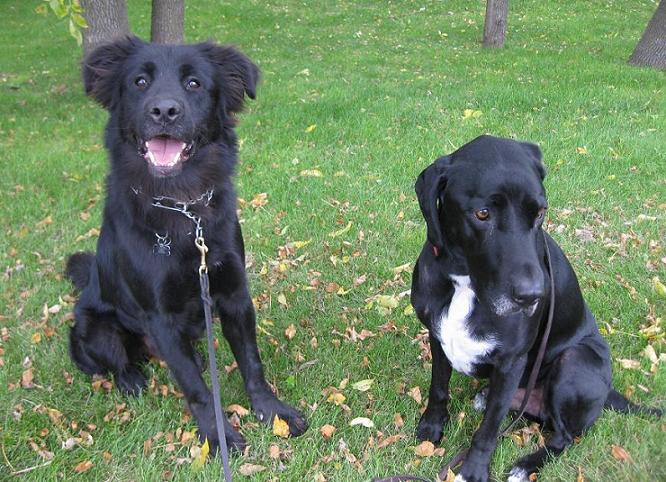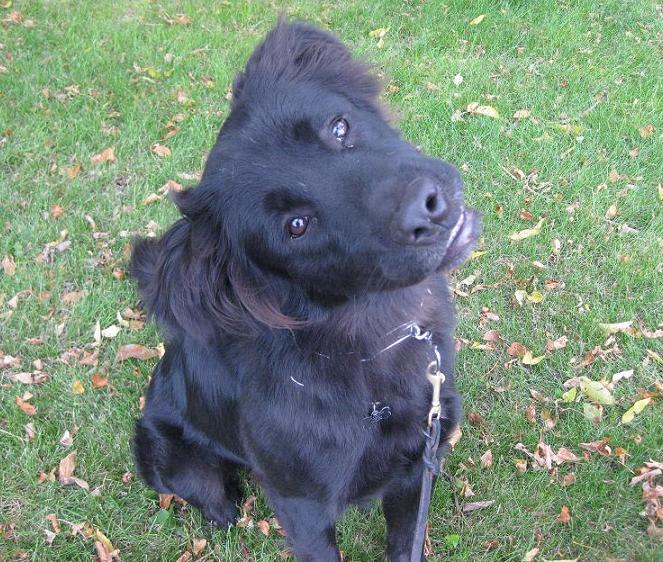Because we don’t have quite enough black dog hair in our carpets, Ace and I have been hanging out with rescue dog Morgan this weekend. Check out some photos of him below – he’s a gorgeous retriever mixed with possibly Newfoundland.
Morgan is taller than Ace with twice the energy, but he reminds me so much of how Ace was when I first adopted him – a puppy in a dog’s body with tons of love and pent-up energy, no direction or purpose. He’s friendly and gentle, awkward and clumsy and treat motivated.
It’s hard to know what Morgan’s true personality and energy levels are right now because he’s been in boarding for a few weeks. But when I look at him, I see a great dog with a lot of potential. Although he is a bit unruly and careless, I expect him to be an easy dog to train. I’m told he can scale an 8-foot fence in seconds, and all I can think is someone needs to get this dog into agility! I can’t wait to see what he’s capable of.
It’s pretty obvious I’m going to consider fostering Morgan, but I’ll make the final decision after this weekend. Sometimes a dog’s energy is just not a good match for our household, and sometimes it’s something we can work around. Regardless, I wanted to share some tips for setting a routine for any new dog you bring into your home. For more info, check out my post on why dogs need a routine.
An example of a dog’s daily routine:
Below is a tentative daily schedule for Morgan. I’m using him as an example, because this is pretty much the routine I follow with any new foster dog.
The routine gives the dog plenty of exercise while assuming the owner must go to work and have a life beyond her dog. I designed the routine based on a 9-5 workday. Even though I have a more flexible schedule than others, this is something an average person could follow if she were dedicated to the dog.
45-minute structured run along my bike first thing in the morning (or a run without the bike, depending on the dog’s leash manners – Morgan’s are pretty good)
15 minutes of basic obedience work – sit, stay, down, etc.
Breakfast – put food away if not eaten within five minutes
Kennel time for a few hours – stocked with Kongs and other goodies!
30-minute walk/run around lunch
Back in the kennel for a few hours with different interactive toys/treats
60-minutes of exercise around 5 p.m.
Dinner – put the food away if not eaten within five minutes
Time out of the kennel to play and interact with other pets
Back in kennel for bed time
Will this be enough exercise for Morgan? I guess we’ll find out.
Every dog is different. If the dog is still working on housetraining, he will need more breaks from the kennel (not the case for Morgan). If he has an insane amount of energy, he may need an extra run or a trip to the dog park each day. If he has less energy, perhaps he can get by with one long run and two shorter walks.
No matter what the dog’s energy level is, though, it is important for him to learn how to control that energy. A lot of people make excuses for their dogs’ behavior problems citing that the dogs have tons of energy and act out of control all day long no matter what. This is an excuse. All dogs can learn manners, even if they have a lot of energy.
Why do dogs need a routine?
Dogs need a routine in order to feel confident they are doing the right things in a new environment. This is why it’s so important to establish a routine right away with a newly adopted dog or a foster dog. It prevents bad habits from forming.
A dog that is confused about what is expected of him will feel anxious. He will be more likely to have accidents, destroy property and develop separation anxiety.
Dogs that are not given enough exercise and structure will not learn to control their energy. These are the kinds of dogs that will run around the house or yard all day. They aren’t shown what to do, so they live in complete chaos, as does everyone else in the house.
Establishing a routine will benefit the new dog, as well as the other pets in your house and the humans!
Dog kennel training
Kennel training is an important factor when setting up the dog’s routine.
Even if you work from home or are able to hang out with the dog most of the day, it is still very important to set aside time each day where the dog has “quiet time” in a kennel or small room. It is very important for the dog to learn how to be alone.
Plus, you will eventually want some time away from the dog any way! Dogs that aren’t conditioned to accept time alone are likely to develop separation anxiety.
Morgan became very stressed out when I put him in a crate in my laundry room Friday night. He basically panicked and tried to get out. I moved his crate to a central location between our kitchen and living room in an open area where he can watch us and get used to our daily routines. This settled him.
I carry kibble in my pockets and give him a piece every single time I walk by his kennel while he is quiet – which is every time. When we watched a movie, Morgan hung out in his kennel next to us quietly, and he later slept in his kennel with only one or two woofs of protest.
After Morgan’s first night in the kennel, I ignored him when I came downstairs to make my own breakfast. I ate at the table in front of him, and other than popping a piece of kibble in his mouth for being quiet, I completely ignored him.
Some people may think eating first and in front of your dog is a bit extreme, but it sends the dog a pretty clear message – my life does not revolve around you. Morgan was learning an important lesson: I do not go to him the second I wake up, and he has to learn to be quiet and patient.
Dog separation anxiety
Many dogs will have some form of separation anxiety when moved to a new environment. Usually this anxiety goes away once the dog becomes used to the routine. For more info on this issue, see my post on how to help a dog with separation anxiety.
During Morgan’s first full day with us, I stuck to our routine right away. I took him for a long walk, then I fed him, and then he went back into his crate. It was tempting to bring him along when I left for my first round of pet-sitting visits, but if he’s going to get used to a routine, I have to start right away. He needs to learn that it’s OK to be left alone. I always come back.
So, I left him in his crate with some peanut-butter filled Kongs and bones. I thought this would also give me an assessment of his true separation anxiety levels. Josh was home sleeping, and would be able to tell me if Morgan woke him up or not. The report? A minute of upset barking and then mostly quiet, so I’d say that’s good news!
Do you have any tips for setting up a routine for a new dog?
If you recently got a puppy, you may be interested in my post on how to train a puppy.




APRIL
Tuesday 10th of September 2013
HI.. I HAVE 3 WEEK OLD PUPPY CAN I TRAIN HIM NOW OR SHOULD I WAIT FOR 1MONTH BEFORE I CAN TRAIN HIM. I ALSO RED YOUR WEBSITE ON 13 TIPS TO TRAIN A PUPPY, CAN MY PUPPY GO OUTSIDE AT AN EARLY AGE? I'M TRAINING HIM TO SOLID FOODS BUT HE CAN'T EAT MANY CAUSE I THINK HE'S CHOKING AND EVERYTIME HE'S EATING HE ALWAYS SNEEZE WHAT SHOULD I DO? BUT THE FOOD WAS MASHED BEFORE I GIVE IT TO MY PUPPY.
APRIL
Tuesday 10th of September 2013
hi.. i have 3 week old can i train him now or should i wait for 1 month before i train him? about feeding him we give him now solid puppy food and bottle fed milk but everytime he eats mashed puppy food with water he always sneeze and it feels he's choking. how do i train him? we let him now outside his kennel and everytime we let out him in his kennel and let him in the house he always pee.. can i let him out of the house at an early age?
Ludwig
Wednesday 13th of October 2010
Hahaha, my Lab princess tried imitating my alarm tune "lucky I'm in love with my best frd"...hahaha! She knows how to tug at my heart strings ;)
Lindsay Stordahl
Wednesday 13th of October 2010
Sounds like she's a smart dog!
jan
Saturday 25th of September 2010
Morgan is adorable.
Dogs seem to have a built in clock. My dogs get a little stressed when things don't happen at the right time.
Lindsay Stordahl
Saturday 25th of September 2010
God forbid dinner is 20 minutes late.
Apryl
Tuesday 21st of September 2010
What a cool doggie friend, seems so nice! As for routines, Gus has an internal timer that knows when it's time for breakfast and dinner. It's pretty funny if we run late he gets really funky!
Lindsay Stordahl
Thursday 23rd of September 2010
Oh gosh, our animals typically eat around 5:30, but they let me know it's getting close to dinner time by about 4:30! Sometimes I have to just put the cats in the laundry room and Ace in his kennel because I don't want to be harassed.